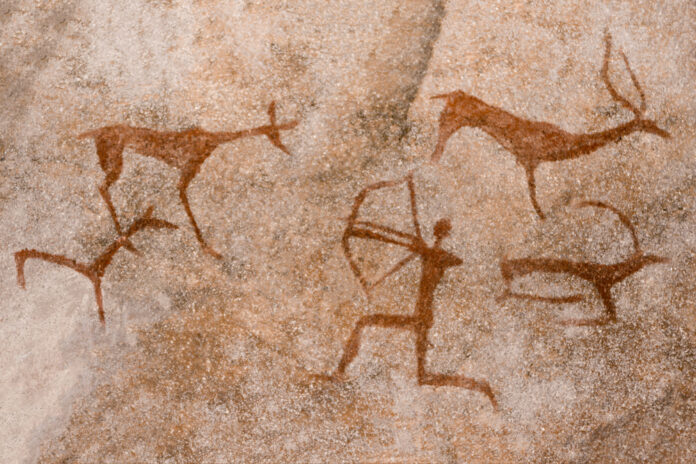You’ve heard of diets like the paleo diet, which claim to harken back to the foods of our ancestors, recreating the diets that we would have eaten during the Paleolithic or Stone Age. It’s a reference to eating the way we’re naturally supposed to eat, identifying the foods that are healthiest for human consumption.
However, according to experts, these diets present a number of unlikely scenarios. First, early humans didn’t shop at the health foods store or choose foods that best suited their gastrointestinal tracts. Rather, they ate what they could gather and what they could hunt.
They had more choices depending on what part of the globe they called home and how adept they had become at surviving. But it was still about day-to-day survival rather than longevity. And though it’s hard to know for sure, early humans likely didn’t live long enough to contract many of the diseases that plague humans today.
The Early Homo Sapien Diet
“I like to think of the biosphere, the part of the planet that harbors life, as a giant buffet,” says Peter Ungar, an anthropologist at the University of Arkansas in Fayetteville, Arkansas. “All the animals are picking and choosing from whatever items are available to them.”
According to Ungar, there’s a lot that we don’t and can’t know about the early human diet. We know that they ate meat based on the archeological evidence of animal bones found at sites and weapons used to hunt, but we don’t know the amount, Ungar says. He adds that we can make the assumption that the amount of meat that was eaten would have varied over time depending on its availability. But it likely wasn’t that much.
Nature serves up the items depending on when (the season) and where (the location) early humans were located around the globe. Ancient tribes in Alaska would have eaten very differently from those in East Africa or Europe.
We likely would have eaten a variety of foods, whether fruit, greens, meat, fish, or wild grains. All of these items were eaten, and the most calorically dense foods were grabbed first.
Read More: Which Animals Did Early Humans Mainly Hunt?
Meals Are a Human Phenomenon
There’s also no way to know how frequently our ancestors ate meals or had fixed times when people gathered together to eat. One thing that we do know, says Ungar, is that meals are something that make us uniquely human.
“We’re one of the few species that has meals,” he says. “Other primates don’t eat meals, they forage and snack throughout the day.” Carnivores might gather around a kill, but that’s just because they’re sharing the hunt.
It’s also not clear when meals would have started. Some experts have argued that it was fire that first led to us gathering together for a meal, but there’s no way to know that for sure. Another theory suggests that it was connected to humans coming together in larger groups. “Still, these are just theories, and there’s not a lot of evidence one way or the other,” says Ungar.
Read More: From Growing Crops to Cooking Food, Fire Shaped Ancient Civilizations
What We Can Learn From Primates
We can also explore what early humans might have eaten by looking back even further into our family tree, to our common ancestor with apes, around 6-8 million years ago, says Claudio Tennie, a cognitive archaeologist based at the University of Tübingen in Tübingen, Germany. It gives us an idea of our diet lineage.
We know that all apes can and will eat fruit if it’s available. It’s calorically dense and tasty, but it’s also worth noting that the fruit available likely wasn’t the same as what we buy at the grocery store. “Fruit has been domesticated, which means that, for the most part, it’s much sweeter than apes would eat,” says Tennie.
Apes also eat meat when given the chance. Some more than others. That doesn’t necessarily mean that they have to hunt because they can also scavenge. It’s also true that the primates who would one day become humans passed down knowledge from one generation to the next of what was edible and what was poisonous, says Tennie.
Additionally, when fruit isn’t available, as in the case of mountain gorillas, apes will eat leaves, though they would still prefer fruit if they have the opportunity. Apes also graze all day long rather than eating meals, which is likely how we would have started.
Early humans didn’t keep a food diary and didn’t live by a certain diet. They ate what they could find that wasn’t poisonous and was less likely to fight back. Their diet was geared toward survival, not longevity. It was all about making it until tomorrow rather than slimming down for swimsuit season.
Read More: The Paleo Diet: Should Modern Humans Eat the Way Our Ancestors Did?
Article Sources
Our writers at Discovermagazine.com use peer-reviewed studies and high-quality sources for our articles, and our editors review for scientific accuracy and editorial standards. Review the sources used below for this article:
Sara Novak is a science journalist based in South Carolina. In addition to writing for Discover, her work appears in Scientific American, Popular Science, New Scientist, Sierra Magazine, Astronomy Magazine, and many more. She graduated with a bachelor’s degree in Journalism from the Grady School of Journalism at the University of Georgia. She’s also a candidate for a master’s degree in science writing from Johns Hopkins University, (expected graduation 2023).
Source : Discovermagazine






